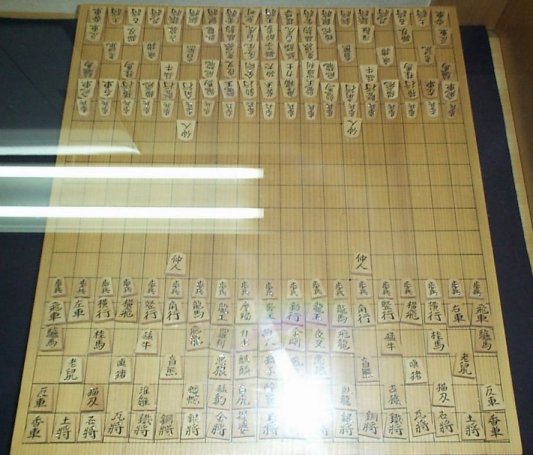Maka Dai Dai Shogi (Ultra Large Large Shogi)
While Maka Dai Dai Shogi is played on a larger board than Dai Dai Shogi it has the same number of pieces per side and has only 50 different types of piece (plus 26 from promotions). In Maka Dai Dai Shogi pieces attain their promoted rank by capture, as is the case in Dai Dai and Tai Shogi variants.
Most of the pieces in Maka Dai Dai Shogi have promoted forms, even the King which promotes to the almost omnipotent Emperor !

SHORT DESCRIPTION:
Maka Dai Dai Shogi is played on a board of 19x19 spaces and each player has 96 pieces (including 19 pawns). Contrarily to what is written by several authors, Maka Dai Dai Shogi is not played on a Go-ban: a Go-ban has 19x19 intersections and that would lead to a 18x18 board. For a Shogi on a Go-ban, look at Ko Shogi.
The fabulous "hook moving" pieces of Dai Dai Shogi are also present in Maka Dai Dai, but together with many of the other powerful pieces, they start directly behind the Pawns making for a more dynamic opening game.
SPECIFIC RULES:
In Nishizawa Teijin's Sho Shogi Zushiki, the Teaching King (promoted Deva) is described as having the combined moves of the Lion Dog (up to 3 squares in any orthogonal or diagonal direction) and the Free King. The moves of the Lion Dog are completely subsumed by the powers of the Free King anyway, so this piece only has one way of moving (ie: as a Free King). Another interpretation of the powers of the Teaching King (mentioned, but not advocated in the Shogi Association rules leaflet) gives it the combined move of the Free King or a 3 square move with full Lion powers. This immensely powerful interpretation is not now considered to be the move intended in Sho Shogi Zushiki.
The King on making a capture promotes to an Emperor. The Emperor has the greatest power of any piece in any of the Shogi variants as it may move in one turn to almost any square on the board, jumping over any number of pieces of either side in the process. The only restriction on the movement of the Emperor is that it may not capture an enemy piece that is protected by another piece. It is this rule which prevents the Emperor from simply capturing the opposing King on its first move.
In Maka Dai Dai Shogi there are no restrictions on the capture of Lions (as there are in Chu Shogi). The Buddhist Spirit (promoted Dark Spirit) has the combined powers of the Lion and Free King, and can move as either (but not both) on any one turn. The Buddhist Spirit is therefore a very mobile and dangerous piece.
The King on making a capture promotes to an Emperor (Jikaitenno). The Emperor has the greatest power of any piece in any of the Shogi variants as it may move in one turn to almost any square on the board, jumping over any number of pieces of either side in the process. The only restriction on the movement of the Emperor is that it may not capture an enemy piece that is protected by another piece. It is this rule which prevents the Emperor from simply capturing the opposing King on its first move.
The promotion rules in Maka Dai Dai Shogi is a promotion by capture as in Dai Dai Shogi and other large cousins).
Unlike in Shogi, captured pieces in Maka Dai Dai Shogi can not be 'dropped' back into play. A captured piece is removed from play and takes no further part in the game.


 (From
Steve Evans, corrected)
(From
Steve Evans, corrected)
HISTORY:
Maka Dai Dai Shogi has the same history as Dai Dai Shogi. It was probably invented in the 15th century as it was included in Shogi rokushu no zushiki. However the main Edo sources do not agree each other on the moves attributed to the pieces.





